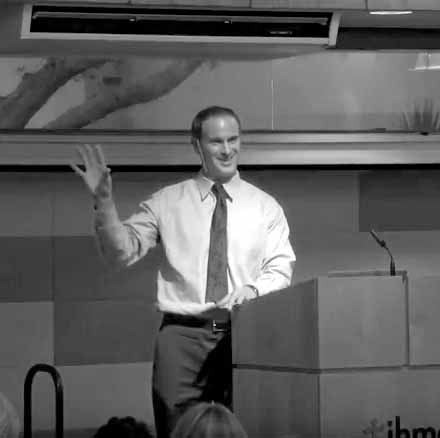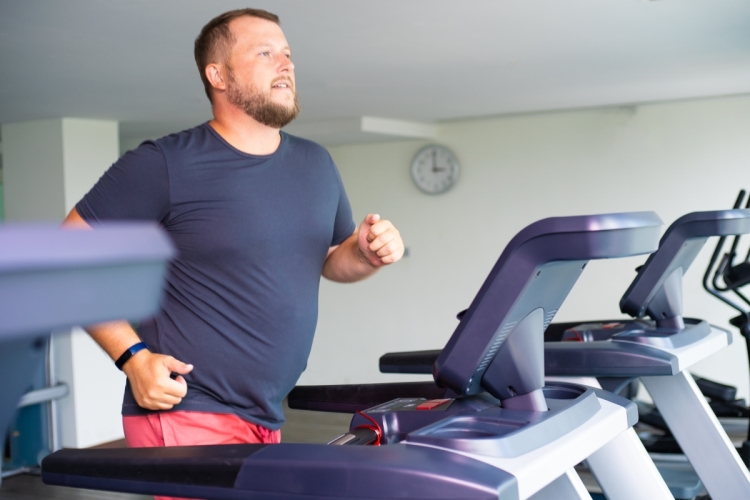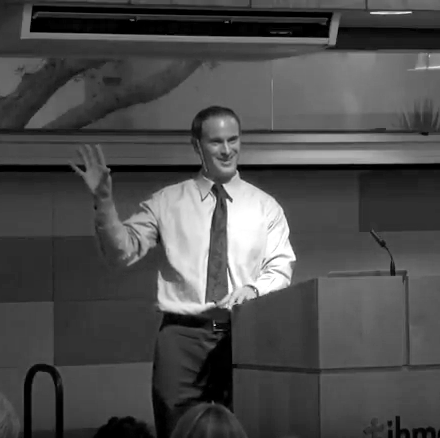How to Break Out of an Intermittent Fasting Plateau
Written by Stephen Anton PhD on June 16th, 2020

With the growing popularity of intermittent fasting, a common question I’ve been getting is:
“What happens when I hit a weight loss plateau and how to break out of it?”
First of all, don’t succumb to negative self-talk. Your body is a master adapter and its goal is for everything to stay the same.
But this, of course, doesn’t mean you can’t achieve your goals, quite the contrary.
Let’s first examine some of the reasons why you could experience a weight loss plateau while practicing intermittent fasting.
Intermittent Fasting Plateau Causes
You could be eating the wrong types of food, eating too late in the evening or too close to bedtime, not fasting for a long enough time, or not fasting for at least 12-14 hours every day – longer is better if the goal is fat loss (1).
Ultimately it comes down to whether or not you are activating your metabolic switch: once you do, your body has no choice but to burn ketones for energy.
What Is the Metabolic Switch and How Is It Flipped?
Flipping the metabolic switch is the very natural process of switching our body’s energy source from glucose to fatty acids and ketones from our body fat.
This shift happens in our bodies while we sleep; instead of storing fat, our body switches to using its fat as an energy source, naturally leading to fat loss (2).
So, you must be wondering, how do I know if my metabolic switch has been activated?
Here are some key points you can use as indicators:
Fasted for at least 12 hours (or 8 hours plus exercise)
No or minimal hunger
Great focus and energy
Calmness
Feeling good

These are all signs that you are using your fat for energy.
On the other hand, if you experience:
Extreme hunger
Headache
Low energy or fatigue
Dizziness
Trouble focusing

Your body has not tapped into its fat stores and probably your precious muscle tissue is your source of energy.
The Keys to Breaking Out of an Intermittent Fasting Plateau
The keys to breaking this plateau are to evaluate your sleep habits, physical activity routine, and the amount and timing of your food intake.
Of course, alcohol intake, particularly late in the evening, can disrupt your metabolism, so this could be a simple change to make (3,4).
It’s best to have an IF coach guide you on how to train your body to flip its metabolic switch and get into the fat-burning zone, but here are a few guidelines to follow.
1) Make Quality Sleep a Priority
Let’s start with sleep since it is something all of us love. The first question is, do you wake up feeling rested?
If so, congratulate yourself; you are in sync with your body’s natural sleep-wake cycle.
The next question is whether you feel consistent, strong energy for all or most of the day. For many people, the answer to this question is no.
If that is your case, you are more than likely not sleeping well; so, let’s consider here three major aspects – the amount, quality, and timing of your sleep.
An easy way to remember this is the 3,2,1 principle – no exercise three hours before bed, no food (or alcohol) two hours before bed, and no electronics one hour before bed.
The environment you sleep in can make a huge difference in your sleep quality (5). It should be dark, quiet, and cold (below 70 degrees). If you get the timing and environment down, then the amount should naturally take care of itself.
Of course, perfect sleep is not always possible, and on days that you don’t sleep well, try to nap in the afternoon or go to bed as early as possible (6).
2) Set a Deadline for Your Last Meal of the Day
To maximize your ability to shift into a fat-burning mode during the night, you should complete your last meal by 8 pm (7).
Dinner should not be your biggest meal; you want to consume most of your calories in the early part of the day, either at your breakfast meal or during your 2nd meal of the day (8).
3) Shorten Your Eating Window
Another strategy is to gradually shorten your eating “window”.
Although the 16:8 (16 hours fasting and 8 hours eating) plan is best for many people in terms of maintaining muscle and losing fat, it may not sufficiently shift the body into a fat-burning mode for everyone.
If this is your case, I would recommend a 17:7 or 18:6 plan to maximize fat burning.
Consistency is also key. Like exercise, the more days per week you practice IF, the better; and your best results will come fasting 5 to 7 days per week.
4) Maximize Exercise Fat Loss
Speaking of exercise, there are two great times of the day to exercise: during your fasting period and your eating window.
However, the types of exercise you perform during each period may slightly differ based on your goals.
Want to take your fat burning to the next level?
Incorporate resistance training four or more days per week, right before your dinner meal or right before your breakfast meal (10).
5) Exogenous Ketones
Taking exogenous ketones is yet another strategy to consider to help break out of an intermittent fasting plateau. Such ketones can quickly put the body into a state of ketosis, and also help train the body to run off ketones as a fuel source.
For this reason, exogenous ketones can complement an otherwise healthy lifestyle. By training the body to utilize ketones as an energy source, the exogenous ketones have the potential to make the fasting time period easier as the body gets used to running off ketones.
The exogenous ketones may also be used to extend the fasting time period, as the ketones are aligned with the physiology of fasting.
Although they would technically be breaking the fast, by taking the ketones at the end of the fast, you can extend the fat burning period and train the body to run off ketones for longer periods of time.
Over time, you can practice extending the fast on the days in which it feels easier, and some days will definitely be easier than others. Gradually, your body will adapt to longer and longer fasting periods.
6) Stay Patient
Stay patient if you hit a plateau, and do not be discouraged; it can be part of your weight loss process. Evaluate how you feel, how your clothes fit, and if your body measurements have changed.
Examine your sleep patterns, your diet, and your physical activity, and make any necessary adjustments. Remember, your scale may not reflect a loss of body fat, especially if you are exercising regularly.
It can be hard to wait, but as long as you don’t give up, you will break out of your plateau, begin losing weight again, and achieve all your body composition goals.
More on intermittent fasting:
Intermittent Fasting Immune System: The Boosting Effects of Fasting
How to Break Out of an Intermittent Fasting Plateau
Written by Stephen Anton PhD on June 16th, 2020

With the growing popularity of intermittent fasting, a common question I’ve been getting is:
“What happens when I hit a weight loss plateau and how to break out of it?”
First of all, don’t succumb to negative self-talk.
Your body is a master adapter and its goal is for everything to stay the same.
But this, of course, doesn’t mean you can’t achieve your goals, quite the contrary.
Let’s first examine some of the reasons why you could experience a weight loss plateau while practicing intermittent fasting.
Intermittent Fasting Plateau Causes
You could be eating the wrong types of food, eating too late in the evening or too close to bedtime, not fasting for a long enough time, or not fasting for at least 12-14 hours every day – longer is better if the goal is fat loss (1).
Ultimately it comes down to whether or not you are activating your metabolic switch: once you do, your body has no choice but to burn ketones for energy.
What Is the Metabolic Switch and How Is It Flipped?
Flipping the metabolic switch is the very natural process of switching our body’s energy source from glucose to fatty acids and ketones from our body fat.
This shift happens in our bodies while we sleep; instead of storing fat, our body switches to using its fat as an energy source, naturally leading to fat loss (2).
So, you must be wondering, how do I know if my metabolic switch has been activated?
Here are some key points you can use as indicators:
Fasted for at least 12 hours (or 8 hours plus exercise)
No or minimal hunger
Great focus and energy
Calmness
Feeling good

These are all signs that you are using your fat for energy.
On the other hand, if you experience:
Extreme hunger
Headache
Low energy or fatigue
Dizziness
Trouble focusing

Your body has not tapped into its fat stores and probably your precious muscle tissue is your source of energy.
The Keys to Breaking Out of an Intermittent Fasting Plateau
The keys to breaking this plateau are to evaluate your sleep habits, physical activity routine, and the amount and timing of your food intake.
Of course, alcohol intake, particularly late in the evening, can disrupt your metabolism, so this could be a simple change to make (3,4).
It’s best to have an IF coach guide you on how to train your body to flip its metabolic switch and get into the fat-burning zone, but here are a few guidelines to follow.
1) Make Quality Sleep a Priority
Let’s start with sleep since it is something all of us love.
The first question is, do you wake up feeling rested?
If so, congratulate yourself; you are in sync with your body’s natural sleep-wake cycle.
The next question is whether you feel consistent, strong energy for all or most of the day.
For many people, the answer to this question is no.
If that is your case, you are more than likely not sleeping well; so, let’s consider here three major aspects – the amount, quality, and timing of your sleep.
An easy way to remember this is the 3,2,1 principle – no exercise three hours before bed, no food (or alcohol) two hours before bed, and no electronics one hour before bed.
The environment you sleep in can make a huge difference in your sleep quality (5).
It should be dark, quiet, and cold (below 70 degrees).
If you get the timing and environment down, then the amount should naturally take care of itself.
Of course, perfect sleep is not always possible, and on days that you don’t sleep well, try to nap in the afternoon or go to bed as early as possible (6).
2) Set a Deadline for Your Last Meal of the Day
To maximize your ability to shift into a fat-burning mode during the night, you should complete your last meal by 8 pm (7).
Dinner should not be your biggest meal; you want to consume most of your calories in the early part of the day, either at your breakfast meal or during your 2nd meal of the day (8).
3) Shorten Your Eating Window
Another strategy is to gradually shorten your eating “window”.
Although the 16:8 (16 hours fasting and 8 hours eating) plan is best for many people in terms of maintaining muscle and losing fat, it may not sufficiently shift the body into a fat-burning mode for everyone.
If this is your case, I would recommend a 17:7 or 18:6 plan to maximize fat burning.
Consistency is also key. Like exercise, the more days per week you practice IF, the better; and your best results will come fasting 5 to 7 days per week.
4) Maximize Exercise Fat Loss
Speaking of exercise, there are two great times of the day to exercise: during your fasting period and your eating window.
However, the types of exercise you perform during each period may slightly differ based on your goals.
Want to take your fat burning to the next level?
Incorporate resistance training four or more days per week, right before your dinner meal or right before your breakfast meal (10).
5) Exogenous Ketones
Taking exogenous ketones is yet another strategy to consider to help break out of an intermittent fasting plateau.
Such ketones can quickly put the body into a state of ketosis, and also help train the body to run off ketones as a fuel source.
For this reason, exogenous ketones can complement an otherwise healthy lifestyle.
By training the body to utilize ketones as an energy source, the exogenous ketones have the potential to make the fasting time period easier as the body gets used to running off ketones.
The exogenous ketones may also be used to extend the fasting time period, as the ketones are aligned with the physiology of fasting.
Although they would technically be breaking the fast, by taking the ketones at the end of the fast, you can extend the fat burning period and train the body to run off ketones for longer periods of time.
Over time, you can practice extending the fast on the days in which it feels easier, and some days will definitely be easier than others.
Gradually, your body will adapt to longer and longer fasting periods.
6) Stay Patient
Stay patient if you hit a plateau, and do not be discouraged; it can be part of your weight loss process.
Evaluate how you feel, how your clothes fit, and if your body measurements have changed.
Examine your sleep patterns, your diet, and your physical activity, and make any necessary adjustments.
Remember, your scale may not reflect a loss of body fat, especially if you are exercising regularly.
It can be hard to wait, but as long as you don’t give up, you will break out of your plateau, begin losing weight again, and achieve all your body composition goals.
More on intermittent fasting:
Intermittent Fasting Immune System: The Boosting Effects of Fasting

Get the Beginner’s Guide to Intermittent Fasting
Take advantage of this FREE PDF and learn the basics of intermittent fasting.

Get the Beginner’s Guide to Intermittent Fasting
Take advantage of this 100% free PDF and learn the basics of intermittent fasting.

Get the Beginner’s Guide to Intermittent Fasting
Take advantage of this FREE PDF and learn the basics of intermittent fasting.









